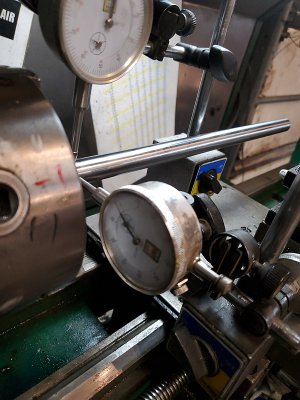View attachment 354677
Absolute readings to the center line are not important here, you're looking for the differences in the average readings of an indicator set to an arbitrary pointless point.
Mount the dial indicator on that carriage and put the anvil in contact with the vertical midpoint of the bar near the chuck. Set the dial to something convenient and then
leave it alone. Rotate the chuck & record the high & low readings, calculate the average reading & record it. (most of the variance here is caused buy three jaw chucks lack of perfection).
View attachment 354699
WITHOUT touching the dial indicator(s) crank the carriage to the tailstock end of the bar.
Again rotate the chuck, again record the average reading.
The difference between the chuck reading and the end of the bar reading is how much the twist has affected the horizontal center line at wherever the end of the bar is.
Example-
Near end readings are +1 & -3 for an average of -2.
Far end is +7 & + 4 for an average of +5.5.
The twist is resulting in the center line at the end of the bar being the difference between -2 & + 5.5 or +7.5
Shim & repeat as necessary.
Check the vertical by mounting the indicator to the high spot on the bar.
Again if you're using a 3 jaw chuck the actual center line will move around a bit anyhow, how much generally depends on the size of the object clamped into it- this is caused by the scroll that moves the jaws not being 100% perfect along it's length) For example with a 17mm bar mine wobbles around by about .75thou, which sounds not too bad but a 5/16" rod shows a ~5 thou wobble & a 2" is about 3 thou.
I got the far end of my lathe shimmed to be about 1.5 thou, that's good enough for me & it will probably move from that whenever it feels like it anyhow.


